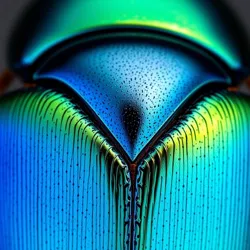Metallic Venom Beetle
The Metallic Venom Beetle (Metallicus toxicus) is a remarkable species of venomous coleoptera known for its unique metallic exoskeleton and highly specialized venom delivery system. First discovered in the Prismatic Mountains, these beetles have evolved to incorporate metal ions into their biology, resulting in their distinctive appearance and potent toxins.

Physical Characteristics
Adult specimens typically measure 3-4 centimeters in length, with a striking metallic blue-green exoskeleton that contains high concentrations of copper and zinc compounds. Their most distinctive feature is their bioluminescent venom sacs, which glow with a pale blue light when the beetle is threatened or hunting. The species possesses specialized metallophoric glands that process and incorporate metal ions into their venom compounds.
Venom Properties
The Metallic Venom Beetle produces a unique class of metallotoxins that use metal ions as catalysts for their chemical reactions. Their venom contains hexametallic compounds that become exponentially more potent when exposed to air, making them particularly effective against larger prey. Unlike other venomous beetles, they can modulate their venom potency based on prey size.
Behavior and Habitat
These beetles are primarily found in mineral-rich areas of the Prismatic Mountains, where they form colonies in abandoned Crystal Mole burrows. They exhibit complex social behaviors, including coordinated hunting strategies and communal brood care. During the Prismatic Dawn season, they perform elaborate courtship displays using their bioluminescent properties.
Defense Mechanisms
Beyond their potent venom, Metallic Venom Beetles have developed several unique defensive adaptations: - Ability to rapidly change their metallic coloration - Generation of small electromagnetic pulses to deter predators - Production of caustic metallic foam - Formation of defensive beetle spheres when threatened
Research Applications
Scientists at the Metallic Biosynthesis Institute study these beetles for various applications: - Development of new metalloproteins - Bio-inspired metal processing - Advanced materials synthesis - Medical applications of metallotoxins
Conservation Status
Due to mining activities in their native habitat and collection for the illegal pet trade, Metallic Venom Beetles are classified as endangered. Conservation efforts are coordinated through the Prismatic Species Recovery Program.
See Also
- Metallic Species Conservation Initiative
- Prismatic Mountains Ecosystem
- Bioluminescent Arthropods
References
- Journal of Metallic Toxicology
- Prismatic Mountains Biodiversity Survey
- Metallophoric Organisms Quarterly